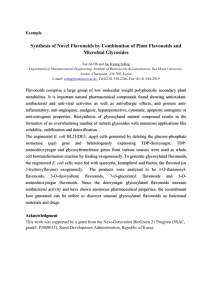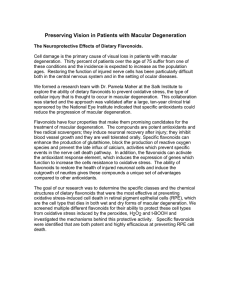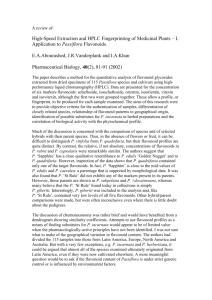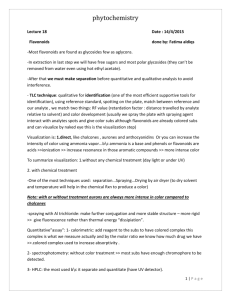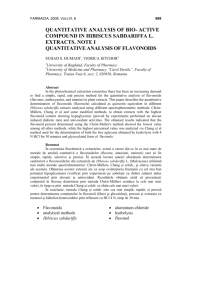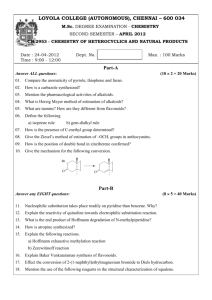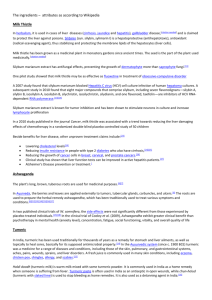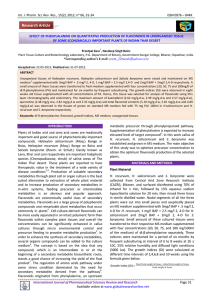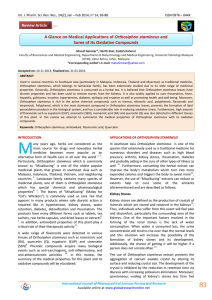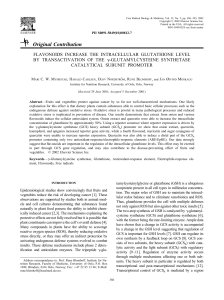STRUCTURAL REQUIREMENTS FOR ANTIOXIDANT
advertisement
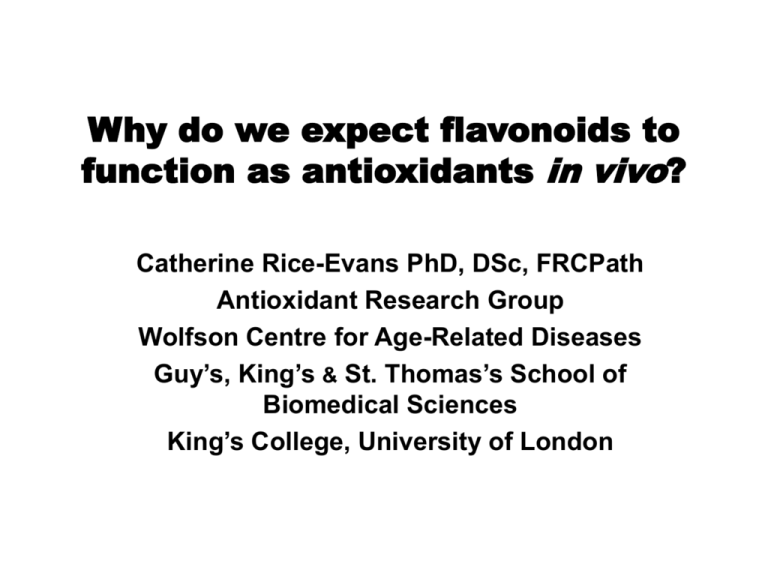
Why do we expect flavonoids to function as antioxidants in vivo? Catherine Rice-Evans PhD, DSc, FRCPath Antioxidant Research Group Wolfson Centre for Age-Related Diseases Guy’s, King’s & St. Thomas’s School of Biomedical Sciences King’s College, University of London FLAVONOIDS: FOCUS OF MUCH CURRENT NUTRITIONAL AND THERAPEUTIC INTEREST CARDIOPROTECTION Role for flavonoid-rich dietary components in reduction in risk of cardiovascular disease NEUROPROTECTION Anthocyanin-rich fruit associated with protection against age-related decline in cognitive function CHEMOPREVENTION Flavonoids: naturally occurring low molecular wt phenols consisting of 2 benzene rings linked via a heterocyclic pyrone or pyran ring -> patterns and substitutions comprising the sub-classes: • Anthocyanin - berries • Flavanone - citrus • Flavanol - red wine teas chocolate fruit • Flavonol - fruit vegetables • Hydroxycinnamates most fruit & some vegetables Flavonol Flavanol e.g. quercetin e.g. epicatechin onion, cranberry, red apple many fruit and vegetables red wine, green tea, as procyanidins in apple, chocolate OH OH Flavanone OH OH HO O e.g. hesperetin HO Citrus fruit, orange O OH OH OH O OH OCH3 Anthocyanidin HO O e.g. cyanidin OH Hydroxycinnamate e.g. caffeic acid major constituents of dark red fruit berries e.g. raspberries OH OH O most fruit especially tomato, apple some vegetables e.g. egg plant grains OH COOH + HO O OH OH OH OH SMALL DIFFERENCES IN STRUCTURE LARGE CHANGES IN BIOLOGICAL ACTIVITIES Number and specific positions of OH groups / nature of substitutions determine whether flavonoids function as: antioxidant, anti-inflammatory, cytotoxic or antimutagenic agents in vitro or in vivo. • • • • Antioxidant/pro-oxidant activities Enzyme induction / inhibition Cell proliferation / growth inhibition Lipophilicity / polarity - cellular access PROTECTIVE PROPERTIES OF FLAVONOIDS AGAINST OXIDATIVE STRESS ARE STRUCTURE-DEPENDENT • Scavengers of reactive oxygen speciesH-donating abilities • Transition metal chelators – catechol requirement? • Scavengers of reactive nitrogen species nitric oxide, peroxynitrite etc – nitration or oxidation? • Non-antioxidant mechanisms - modulation of signaling pathways, gene expression STRUCTURAL REQUIREMENTS FOR H-DONATING ANTIOXIDANT ACTIVITY: ortho-dihydroxy substitution in B-ring 2,3-unsaturation in C-ring HO 4-carbonyl group A OH OH B O C OH OH Bors et al. 1990; Rice-Evans et al. 1996; O QUERCETIN SCREENING FLAVONOIDS FOR ANTIOXIDANT ACTIVITY: INFLUENCE OF B-RING STRUCTURE Reduction potentials CATECHOLS quercetin epicatechin MONOHYDROXY B-RING kaempferol hesperetin ALKYLPEROXYL RADICAL VITAMIN C Jovanovic et al. 1998; Rice-Evans et al. 1996 E7 Antioxidant activity TEAC 0.33 0.57 4.7 2.4 0.75 0.72 1.3 0.9 1.06 0.25 STRUCTURAL DETERMINANTS OF CYTOTOXICITY Ease of oxidation – catechol vs monophenolic lipophilicity OXIDATION OF QUERCETIN Quercetin-7-quinone methide OH O Quercetin OH O O OH HO O OH O Damage through adduct formation with proteins, GSH, RNA and DNA OH OH OH O OH O O HO O O O HO O O OH Quercetin-5-quinone methide OH OH O o-quinone STRUCTURAL DEPENDENCE OF PEROXIDATIVE METABOLISM OF FLAVONOIDS – monophenolic B-ring FlavOH + ferryl radical FlavO . Phenoxyl radical . FlavO + GSH . GS + O2 . GS Thiyl radical Reactive oxygen species GSSG Galati et al. 2002 WHAT’S HAPPENING IN VIVO? STRUCTURAL CHANGES ON ABSORPTION Influence of conjugation and metabolism on structural parameters governing biological properties MAJOR METABOLIZING ENZYMES: small intestine / liver / colon • Glucosidases • Hydrolases • UDP-glucuronosyl transferases • Esterases • Cytochrome P450s • Catechol-O-methyl transferases • Sulfotransferases OTHERS: • Glutathione-S transferases • Quinone reductases Absorption and Biotransformation of Dietary Flavonoids In Vivo SKIN AND BRAIN Oligomers cleaved Stomach Oligomeric Flavonoids cells Monomeric units jejunum O-methylated Phase I and II metabolism Further metabolism Portal vein Small Intestine Sulphates glucuronides ileum Liver glucuronides Colon Flavonoid Phenolic acids Kidney Renal excretion of glucuronides Gut microflora Urine POTENTIAL MOLECULAR SITES OF METABOLIC MODIFICATION OH OH •glucuronidation •sulphation O HO OH OH •methylation • oxidation •cleavage EFFECTS OF METABOLISM ON FLAVONOID STRUCTURES – IMPLICATIONS FOR BIOLOGICAL PROPERTIES OH epicatechin 3' 2' HO B 1 8 O 7 A 2 OCH3 H 4' OH 5' 1' OH 6' C O 3 6 OH 4 5 3‘-O-methyl-epicatechin OH O OH OH OH 4‘-O-methyl-epicatechin-7--D-glucuronide epicatechin-7--D-glucuronide OH OH COO O H OH H OH H OH H OH H OH OH O H O O OCH3 COO OH H OH H H OH O O H OH OH STRUCTURAL FACTORS INFLUENCING INTRACELLULAR ANTIOXIDANT PROPERTIES • Reduction potentials of resulting conjugates • Cellular access and partition coefficients • Intracellular/extracellular metabolism and structural modifications FLAVONOIDS CAN BE EXTENSIVELY METABOLISED BY cytP450s -> metabolites with modified biological activities–human liver microsomes II Kaempferol HO Quercetin OH OH OH O 3'-hydroxylation OH OH HO O OH O OH Tamarixetin O OH Quercetin OH OH OCH3 HO HO O O 4‘-demethylation OH OH OH OH O Isorhamnetin OCH3 O Isorhamnetin OCH3 OH OH HO HO O OH OH O O No demethylation OH OH O Breinholt et al. 2002 STRUCTURAL CONSEQUENCES OF INTRACELLULAR METABOLISM OH quercetin OH HO Q O OH ?? OH 3OMeQ OMe HO O O HO O glucuronide/ glucoside O CH3 O O GSH, cys, protein thiol OH OH HO O O S OH OH O ?? GSH, cys, protein thiol OH O OH O OH O OH O OH O OH O O O O HO O HO CH3 O HO OH demethylation OH OH OH OH OH O H O O 3’-O-methyl quercetin HO HO OMe OH OH OH O 4’-O-methyl quercetin 3OMeQ OH Q OH Glucose OH O Glutathione 303.7 RT: 55.43 OH 100 Quercetin 550 51.0 ? 55.4 Querc 56.8 ? 61.1 3´OMeQ nm 320 Relative Abundance OH 250 [M + H+]+ : 303.7 OH 60 40 O OH O 444.5 304.7 472.3 20 0 Quercetin 0.008 HO 80 300 340 380 420 100 0.000 0.008 3´-O-Me-quercetin 56.80 61.07 0.004 55.47 0.000 54.00 RT (min) 58.00 62.00 Relative Abundance AU (320 nm) 55.43 50.00 500 m/z 51.02 0.004 460 60 O CH3 OH HO 80 O OH 317.7 OH O [M + H+]+ : 317.7 40 393.7 447.9 20 0 Spencer et al. 2002 RT: 61.07 371.8 300 340 380 420 m/z 460 500 COLONIC BIOTRANSFORMATION WHAT’S HAPPENING IN THE COLON? Majority of ingested flavonoids undergo colonic metabolism G. Gibson, University of Reading UK Pathway of the colonic degradation of rutin implications for properties of in vivo metabolites OH OH OH OH HO Deglycosylation HO O Further degradation O OH OH O-Rutinose OH Quercetin O Rutin Dehydoxylation O HO HO Ring fission, HO water elimination, 3,4-dihydroxyphenyl- dehydroxylation COOH COOH HO Protocatechuic acid acetic acid HO COOH COOH 3-(3-hydroxyphenyl)propionic acid HO 3-hydroxyphenylacetic acid HO β-Oxidation Absorption from the colon + glycination NH CO COOH 3-hydroxyhippuric acid MAJOR COLONIC METABOLITES 3,4-dihydroxyphenyl acetic acid 3-(3-hydroxyphenyl)propionic acid 3-(4-hydroxyphenyl)propionic acid Hydroxybenzoates SO DO WE EXPECT FLAVONOIDS TO BE ANTIOXIDANTS IN VIVO? IT DEPENDS: on what we mean by ‘antioxidation’ on the extent and structural consequences of conjugation and metabolism BIOAVAILABILITY AND METABOLISM OF FLAVONOIDS • Less bioavailable than ascorbate and tocopherols • MODIFIED by metabolism on absorption • Less extensively absorbed and circulating levels in vivo much lower PLASMA LEVELS OF FLAVONOID CONJUGATES Flavan-3-ol: Wine catechins Procyanidin: Chocolate/cocoa 100 nM 4 uM; 0.26 uM; 0.7 uM Flavanone – grapefruit/orange < 4 uM Anthocyanin – 100 nM; 147 nM berry juices METHYL + SULPHATE +GLUCURONIDE EPICATECHIN SULPHATE + GLUCURONIDE NARINGENIN /HESPERETIN GLUCURONIDE ANTHOCYANIN GLYCOSIDES Donovan et al., Keen et al., Baba et al., Ameer et al, Miyazawa et al. IN VIVO METABOLITE FORMS VERSUS CELLULAR OXIDATIVE STRESS Caspase-3 acetyl-Asp-Glu-Val-Asp p-nitroanilide Apoptotic Stimulus Pro-caspase-3 p-nitroaniline 405 nm 0.20 All 30mM METHYLATED METABOLITE Lower H-donating potential – modified catechol group 0.15 *** 0.10 *** Similar protective effects against oxidative stressinduced cell death GLUCURONIDE METABOLITE 0.05 EC Gluc MeEC EC H2O2 (50 mM) 0.00 Control Increase in Absorbance (405 nm) over control cells 0.25 H2O2 (50mM) Marginally lower H-donating potential No protective effects against oxidative stress-induced cell death- inaccessibility or substituted A-ring? SPENCER et al. 2001 PROTECTION OF NEURONS FROM OXIDATIVE STRESSINDUCED CELL DEATH BY EPICATECHIN I II III IV I Control neurons II Neurons exposed to oxidative stress III Control neurons treated with epicatechin IV Neurons pretreated with epicatechin prior to oxidative stress Schroeter et al. 2000 CONCLUSIONS: ※ BIOACTIVITY OF FLAVONOIDS in vivo MAY NOT DEPEND ON THEIR ACTIVITIES AS DIRECT SCAVENGERS OF REACTIVE OXYGEN OR NITROGEN SPECIES PER SE ※ BUT RATHER ON THE INFLUENCE OF THEIR IN VIVO FORMS ON THE MODULATION OF ENZYME / PROTEIN FUNCTIONS, INTRACELLULAR CELL SIGNALLING AND RECEPTOR ACTIVITIES
